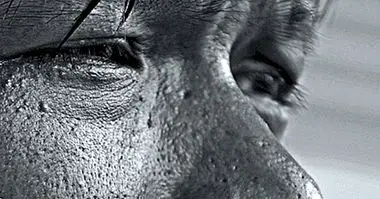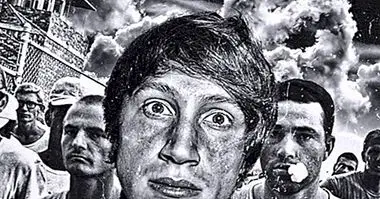Emotional crisis: why does it happen and what are its symptoms?
The word "crisis" is used with different meanings . First, it is necessary to mention that it comes from the Greek word krisis (decision) and krino (separate); thus, it involves rupture but at the same time hope and opportunity. In turn, in China, many people use the term "wei-ji", a word composed of two ideograms: danger and opportunity.
Thus, it is possible to simplify that every crisis alludes to a danger due to the suffering that comes with the loss of what has been lost or of what is about to be lost; For its part, "chance" (opportunity) refers to the means of restoring a new reality from the crisis experienced.
Next we will see what exactly means experience an emotional crisis .
- Maybe you're interested: "The neurotic structure in psychoanalytic psychopathology"
Definitions of crisis
The crisis (whether political, religious or psychological) can be conceptualized in different ways, but there is a word that objectively condenses its meaning: disequilibrium; an imbalance occurred between a before and after .
A crisis event always infers a contextual deviation in which it takes place. It represents a threat of loss of the objectives achieved (be they economic, social, religious, psychological, etc.) that is fraught with anguish. A crisis episode occurs over time, and that time is relatively short (unlike stress), which is marked by a short-term beginning and ending.
The triad that shapes every crisis is: imbalance, temporality and the internal ability to move forward or backward . The emotional crisis, therefore, always forces us to make a decision.
- You may be interested: "What is trauma and how does it influence our lives?"
A drastic change
No crisis is neutral in nature. It always entails an advance or a setback; never goes unnoticed by the affected subject, his family or society itself.
Every crisis has the same succession: conflict, disorder and adaptation (or mismatch as the case may be).
What originates it?
The generator of the crisis It is not the conflict itself, but the response of the subject to said eventuality . That is, the problem is not the problem but the response expressed before the event. For the above, it is completely natural and understandable that in the same event a subject creates a crisis and another does not.
As a synthesis, it is possible to define the crisis as "a transitory ego disorganization with probability of change". That is to say, in a situation of crisis, the "unstable equilibrium" that constitutes the mental health of the individual is broken, but temporarily, not permanently.
But this imbalance is not infertile, since it can strengthen the individual more , giving rise to new forms of behavior or activating diverse mechanisms besides possibilities that until that moment have been unknown even to the affected.
Thus, the crisis, by itself, is not negative, but everything will depend on the approach taken by the subject before any eventuality.
Phases of emotional crisis
From a synchronic perspective, the crisis it can be a concentrated form of anguish . This phenomenon can be decomposed in a simple way into three different elements: stupor, uncertainty and threat.
1. Stupor
The stupor is an element that is always present: it is identified by the fear and inhibition of the individual before the experienced emotions, which are incomprehensible, paralyze it.
The subject in crisis he does not react, he does not seek a way out of his discomfort. All the energy of its being is used to soften the breach opened by the crisis itself; This is done in an attempt to quickly recover the emotional balance. In turn, the manifested imbalance is the origin of the psychic disorganization.
Despite everything experienced, the stupor provides protection to the person of total decompensation and cushion, in a way, the serious consequences of the crisis.
2. Uncertainty
The "uncertainty" eIt's the reflection of the amazement experienced by the subject and is translated as a struggle between opposing forces: choose this exit or the other, choose "this" or "that". This dichotomous experience serves as an alarm against a real danger or a latent fantasy.
The conjunction between stupor and uncertainty is defined as "confusional anxiety", which is an experience in which Mental chaos predominates for not knowing or understanding what is happening both inside and outside of himself.
3. Threat
The third element is the "threat". Any imbalance presented implies fear of destruction . The "enemy" is outside of oneself and defensive behaviors are presented as distrust or aggression. The crisis, at this point, represents a danger to the integrity of the person's psyche.
Characteristics and symptoms
From the above, it is possible to affirm that the crisis is not self-explanatory but needs the antecedent of the past to be understood.
It is necessary to remember that every crisis has a before and after. An episode of crisis involves facing something that changes suddenly and unexpectedly, and the ideal way out before such a situation is to find emotional balance or to continue in the confusion and psychic disorder.
The evolution of the crisis is normal when the "unstable equilibrium" is achieved in a prudent time, which can not be determined or pigeonholed. Just asking for help to overcome the episode of discomfort is a way to facilitate emotional stability. However, it is possible to point out, as common characteristics to any crisis, the following:
- The fundamental factor, which determines the appearance of the crisis, is the imbalance presented between the difficulty of the problem itself and the resources available to the individual to face it.
- External intervention during the crisis (psychotherapy) can compensate the imbalance produced and guide the individual towards a new harmonious emotional state .
- During an episode of crisis, the individual experience an intense need for help . In the same way, during the episode, the subject is more susceptible to the influence of others than in the periods in which his emotional functioning is balanced or in total disorder.
Bibliographic references:
- Gradillas, V. (1998). Descriptive psychopathology. Signs, symptoms and traits. Madrid: Pyramid.
- Jaspers, K. (1946/1993). General Psychopathology. Mexico: FCE.



















